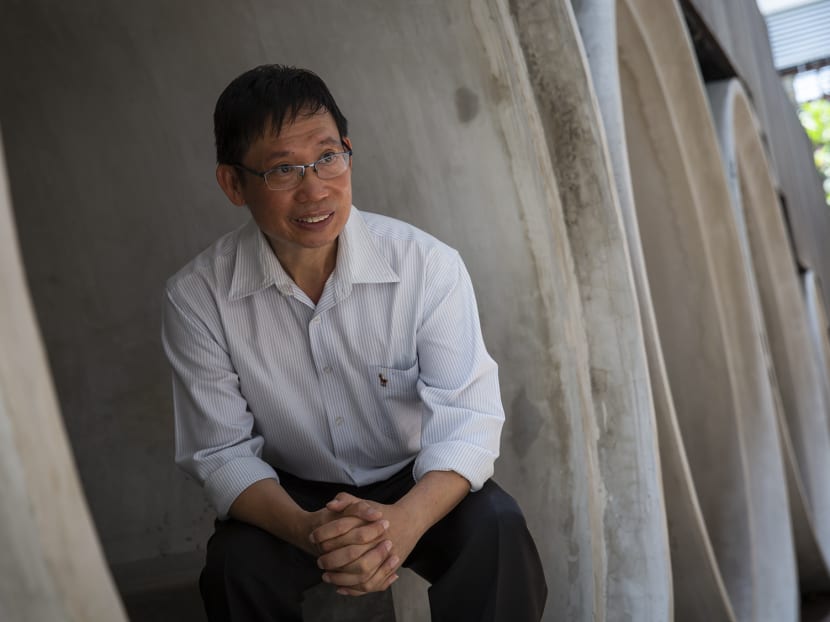Four strokes in a decade, but S’porean businessman refuses to give up
SINGAPORE — Twelve years ago, Mr John Seah was living his dream after leaving his job at a multinational company (MNC) to start his own business.

In an interview with TODAY at the premises of the Stroke Support Station (S3), Mr John Seah said that before his illness, his lifelong ambition was to start his own company.
SINGAPORE — Twelve years ago, Mr John Seah was living his dream after leaving his job at a multinational company (MNC) to start his own business.
But his life of travelling the world to conduct training seminars came to a screeching halt in 2007 when the then 46-year-old suffered his first “mini stroke”, which was followed by three more strokes — two of which were serious — in the span of 10 years that left him wheelchair bound and unable to speak more than a few words.
“It was devastating because suddenly you feel like you can’t do anything,” said the 58-year-old.
“My dreams were scattered all over.”
Since then, Mr Seah’s life has been a journey of recovery, resilience and renewed hope.
In an interview with TODAY at the premises of the Stroke Support Station (S3), Mr Seah said that before his illness, his lifelong ambition was to start his own company.
Located within the Enabling Village in Lengkok Bahru, S3 is a ground-up initiative by volunteers to help stroke patients in their recovery.
In 1997, Mr Seah left his MNC job of over 20 years and founded Everest Innovation, a training company that coaches clients from around the region to develop skills in leadership, management, negotiation and more.
While he led a hectic life which saw him travelling almost every other week, he did not mind as he enjoyed imparting skills to others. He was able to stay in touch with his wife and two children via the Internet and they would occasionally join him for a getaway if his work spanned over the weekends.
“I was thinking of the next project, the next customer, the next portfolio, the next courseware we were going to create,” he said.
FOUR STROKES IN 10 YEARS
It was in 2007 that Mr Seah’s life first took a “devastating” turn when he suffered a Transient Ischemic Attack (TIA), a “mini” form of stroke that lasts only a few minutes.
Before its onset, he was getting ready for bed and brushing his teeth when the entire left side of his body became paralysed.
His wife came to his aid and fortunately for him, he was only temporarily disabled and recovered without incident while he was en route to Tan Tock Seng Hospital in an ambulance.
But this would not be his only brush with the disease, which affects the arteries leading to and within the brain. Stroke is fourth leading cause of death in Singapore and the number one cause of adult disability and the largest cause of long-term physical disability worldwide.
Within a decade, Mr Seah suffered three more attacks in 2012, 2016, and 2017. The second was also a TIA, which he said he barely noticed.
However it was in Mr Seah’s busiest year that he was hit by a serious stroke.
He was giving a presentation in Subang, Malaysia, in 2016 when a client noticed that his speech was slurred and his movements were uncoordinated.
He was suffering from an Ischemic Stroke, a more common form of the disease that occurs when an artery supplying blood to a part of the brain is blocked.
He was rushed to the hospital in Kuala Lumpur before he was eventually transported back to Singapore.
But the damage to his body was permanent and he was unable to move his left limbs.
With only one functional arm and leg, Mr Seah fretted over the sustainability of his business.
It was during this dark period that the Christian found solace in his faith.
Looking at the medical report from his doctors, Mr Seah realised that his cholesterol levels and blood pressure — both risk factors for strokes — were “okay”.
He was also previously fit enough to even “overtake the young boys” when doing the 2.4km run for the Individual Physical Proficiency Test (IPPT).
He also realised that the root cause of his strokes was due to stress brought on by weeks of working non stop.
“My body just broke down because I did not rest,” he said.
He then began delegating more work to his other trainers and spent a year focused on his rehabilitation.
Just when he was almost able to walk again, he was hit by another setback in 2017 when he suffered his fourth stroke, a Hemorrhagic Stroke that saw bleeding in his brain.
That day, Mr Seah said he “made the mistake” of scheduling two consecutive meetings with potential candidates for his company. He and his caregiver were rushing between the meetings when the stroke struck.
.embed-container { position: relative; padding-bottom: 56.25%; height: 0; overflow: hidden; max-width: 100%; } .embed-container iframe, .embed-container object, .embed-container embed { position: absolute; top: 0; left: 0; width: 100%; height: 100%; }NEW LIFE, NEW GOALS
The aftermath of the last stroke left him wheelchair bound and unable to speak more than a few words at a time before becoming breathless.
But Mr Seah refused to fall into depression and relied on his faith and the support of his family instead.
Keeping a positive attitude was key as he said: “If you have a good brain, then even if you have one hand, one leg…you can still achieve your dreams. You just need to refocus them.”
Rather than being too invested in his work, he decided to let go and set himself a new goal to spend more time with his family and travel with them.
“I needed to get back to having a normal relationship with my family again,” he added.
It also helped that he discovered S3’s Walk-On programme around this time. The initiative was started in 2017 to help stroke survivors improve their walking speed, efficiency and strength.
While the programme can currently only accommodate 28 people and has a wait time between three to four months, S3 will be opening a new centre on May 28.
Located at Jurong Point shopping mall, it will be twice as large as the first centre. The two facilities will have the capacity to care for about 1,000 stroke patients annually.
For Mr Seah, the programme’s sports consultants worked with him to design a set of activities to help achieve his new dream. These included simulating getting on and off a tour coach with the aid of exercise machines, data analytics and one-on-one training sessions.
Gradually, he progressed from being wheelchair bound to using a walking frame, then a quad stick before moving on to a walking stick.
“Each time I upgraded myself, I patted myself and said ‘good boy’. I was so happy!”
The good natured, humorous man has since come a long way as he is now able to walk without any aids under the close supervision of his caregiver. He was also able to conduct an hour-long interview with TODAY without difficulty.
He also has a new goal for the future. “My goal is to be able to run my IPPT independently in a public facility,” he said.
But more importantly, he wants to share his experience with other stroke survivors at S3 to motivate them to “get out of their wheelchair, seek help, and not fall into depression”.
STROKE: SINGAPORE’S FOURTH LEADING CAUSE OF DEATH
Stroke remains a cause of concern as it can “happen to anyone at anytime”, said S3’s chief executive officer Wong Chiang Yin.
While statistics have shown that the elderly have a higher risk of stroke, “the incidence of younger stroke patients is becoming more common today”, he added.
With 26 occurrences of stroke a day, it is the fourth leading cause of death in Singapore.
Dr Wong also provided more information on the disease.
FACTS
-
There are 8,000 new stroke cases reported each year.
-
Stroke is the number one cause of adult disability and the largest cause of long-term physical disability worldwide.
-
Stroke mortality in Singapore fell from 20.8 per 100,000 population in 2011 to 14.7 per 100,000 population in 2016. “This shows that more people are living with the condition,” said Dr Wong.
-
The average age of stroke patients who suffer from Ischaemic Stroke is 69. There were 6,014 episodes reported in 2016, of which five per cent did not survive beyond 30 days.
-
The average age of stroke patients who suffer from Hemorrhagic Stroke is 64. There were 1,383 episodes reported in 2016, of which 22 per cent did not survive beyond 30 days.
-
One in five patients who suffered from stroke were under the age of 55.
-
If a patient survives the first stroke, the probability of getting another stroke in the next five years is approximately 30 per cent.
HOW TO SAFEGUARD YOURSELF
-
Attend regular health screenings
-
Keep diabetes, high blood pressure and high cholesterol under control by taking the required medication as advised by the doctor
-
Have a balanced diet comprising fruits, vegetables and whole grains and food that is low in salt and fat
-
Avoid smoking
-
Have at least 20 minutes of physical activity a day
SIGNS OF A STROKE
Dr Wong said it is crucial for stroke patients to seek help within the “golden hours”, which is the first three hours after the onset of stroke symptoms.
Patients who reach hospitals within the golden hours are more likely to recover with less or no disability, he said.
The easiest way to identify if someone is suffering from the disease is to remember the acronym: F.A.S.T.
-
Face: Dropping on one side
-
Arm: Weakness on one side
-
Speech: Difficulty in articulation
-
Time: Call 995 immediately if you spot any of these signs
WHAT CAREGIVERS CAN DO
-
Be the pillar of strength. Give the stroke survivor as much support and assurance as possible through actions and words.
-
Be a good listener. Stroke survivors may experience speech impairment which prevent them from expressing themselves clearly. Be patient and lend a listening ear to help them “find new meaning in life,” said Dr Wong.
-
Be gentle but firm when necessary. While affection is good, doing everything for a stroke survivor may slow down their recovery process as they need to learn to be as independent as possible.
-
Be the link to the world. A frustrating aspect of stroke is that it changes one’s lifestyle. Dr Wong said it is important for caregivers to engage them in activities they enjoy, and help them regain confidence in meeting other people, even strangers.
-
Accept help when offered. “Being the caregiver does not mean that the ownership of the stroke survivor’s recovery falls on you,” said Dr Wong. To prevent burnout, a caregiver can consider seeking help at every stage of the recovery process.








